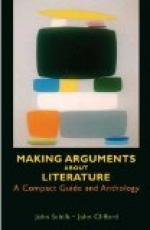The advantage of this form is that if you have set down several assertions as reasons for another, and you are doubtful whether they all belong there, you can test them separately by putting them one by one after the main assertion they are intended to support with a “for” or a “since” between.
You put the assertion first and the reason for it afterwards, because when there is more than one reason in support, if you have the reason first you must then repeat the assertion with each reason, or run the risk of confusion. If under I in the brief on page go, for example, you began with the reason, “In the present system partisan politics determine nominations to office,” and then added the result, “Therefore the city government is inefficient,” you would have to repeat the result with B and C; and when you came to the third degree of support, the repetition would be intolerably clumsy and confusing.
9. Headings and subheadings should not have more than one numbering.
The reason for this rule is also obvious: each heading or subheading marks a step in the argument, and what belongs on one step cannot be on another at the same time. In the brief on page 90 the assertion that “Partisan politics determine nominations to office” is stated as a chief reason for the assertion in the first main issue, that “The admitted inefficiency of the city government at present is due to the system of government.” It would confuse a reader to mark it A I, as if it wore a support also in the second degree.
10. The brief should give references to the evidence or authorities relied on to support assertions.
General references to articles and books which will be constantly referred to should be put at the beginning of the brief. References to specific statements of fact or quotations of opinion should be added as they occur in the brief (see the brief on p. 90).
EXERCISES
1. Criticize the following portion of a brief:
This college should have a longer Christmas vacation, for
I. College life tends to break up family life;
A. Father and son;
B. Younger brothers and sisters;
C. Intimate friends.
2. Criticize the following detached portions of a brief on the proposition, This city should double its appropriation for the public library, and amend them if necessary:
a. II. The funds for
the purchase of books are insufficient and the
staff is inadequate.
b. B. The reading room is
crowded to suffocation, therefore
1. Many people avoid the library.
c. III. Those who oppose
the increased appropriation declare that
A. The library is a luxury for the rich;
hence
1. The rich should support it;
but
2. This is not true, for
a. Most of the borrowers of
books are people
of moderate means; therefore
b. The city should support the
library.




